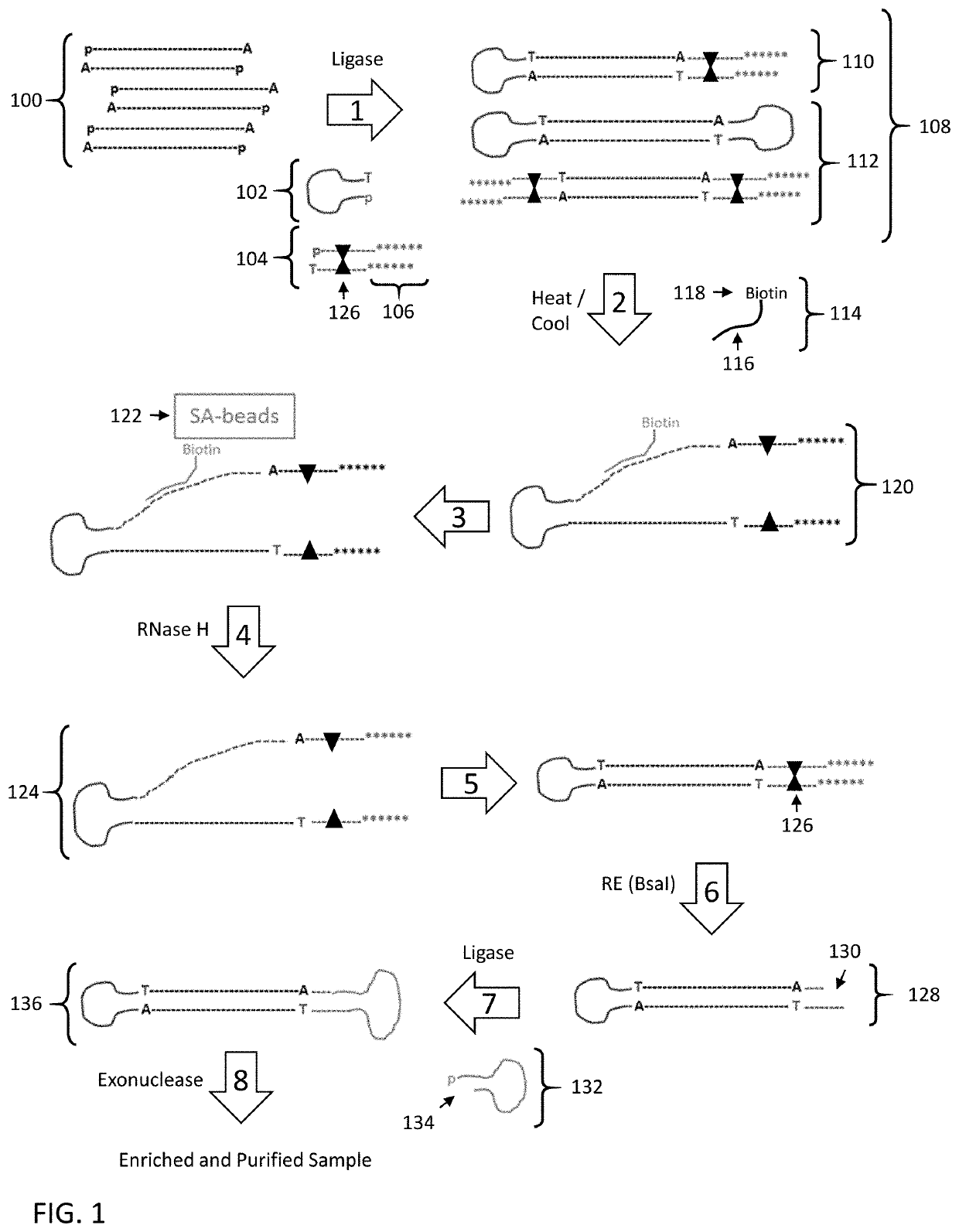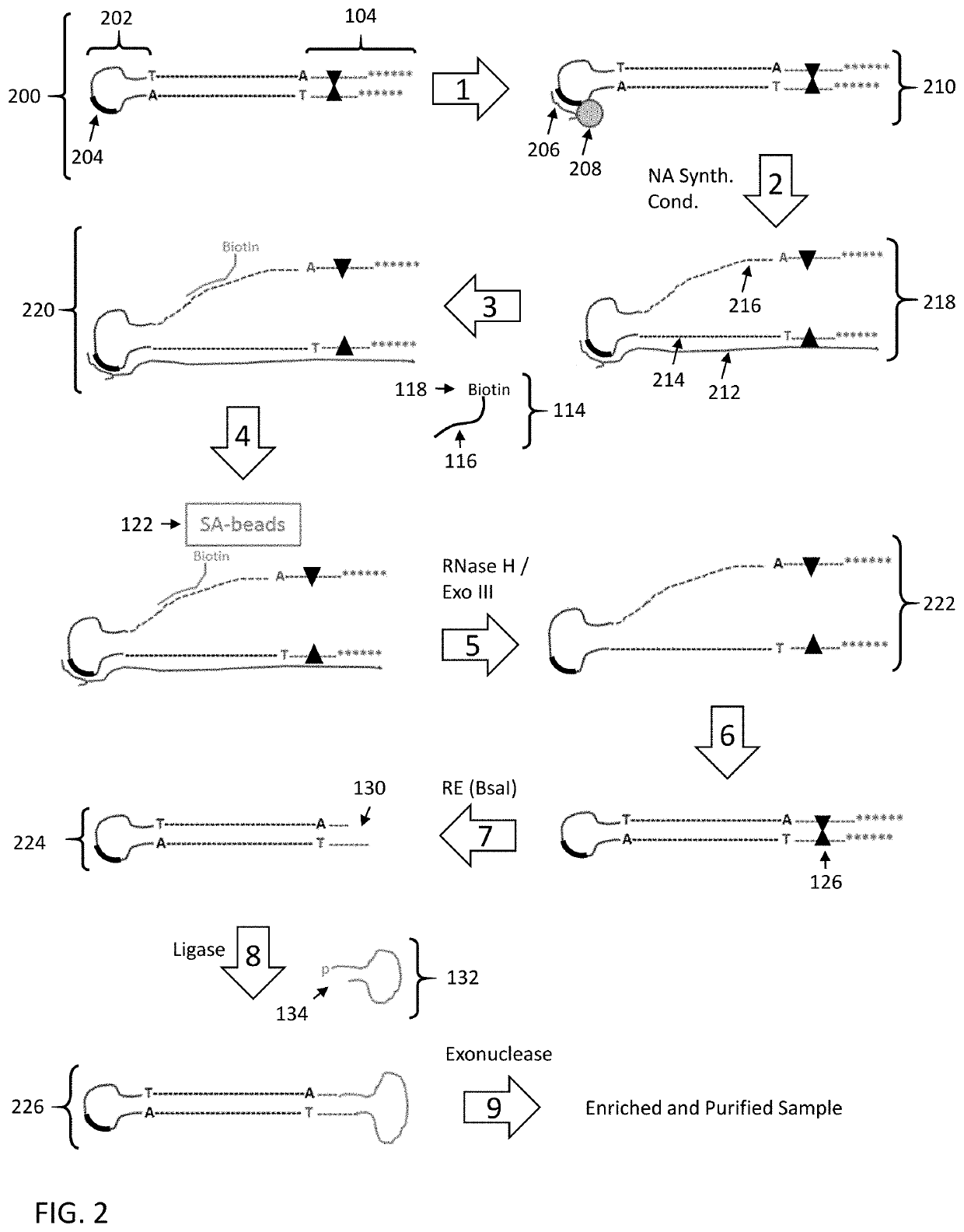Enrichment of DNA comprising target sequence of interest
a technology of target sequences and enrichment, applied in the field of enrichment of dna comprising target sequences, can solve the problems of time-consuming and extremely costly methods
- Summary
- Abstract
- Description
- Claims
- Application Information
AI Technical Summary
Benefits of technology
Problems solved by technology
Method used
Image
Examples
example 1
[0148]The following example employs the strategy as set forth in FIG. 4 to enrich specific nucleic acid fragments from a HindIII digested Lambda DNA sample with asymmetric adapters (a hairpin adapter and a linear adapter).
[0149]Lambda / HindIII Library Construction:
[0150]Lambda DNA was digested to completion with HindIII, end repaired and treated to generate ends having a 3′-A overhang. Hairpin and linear adapters having compatible 3′-T overhangs mixed at a 1:1 molar ratio were added to the digested Lambda DNA fragments under DNA ligation conditions. The hairpin adapter includes a synthesis primer binding site in the single stranded loop region. The linear adapters included a 3′ overhang region on the end opposite the 3′-T ligation site that included a sequencing primer binding site. In addition, the end opposite the 3′-T ligation site included 5′ and 3′ terminal phosphorothioate nucleotides to protect them from exonuclease digestion once the 3′-T ligation site was ligated to a compat...
example 2
[0157]The following example employs the strategy as set forth in FIG. 7 to enrich specific nucleic acid fragments from a HindIII digested Lambda DNA sample with symmetric hairpin adapters (a hairpin adapter at both ends). In this example, the nascent DNA is sequenced rather than the original Lambda / HindIII template (similar to steps 7 and 8 of FIG. 7).
[0158]Lambda / HindIII SMRTBELL® Library Construction (symmetric hairpin adapter-ligated DNA fragments):
[0159]Lambda DNA was digested to completion with HindIII, end repaired, and treated to generate ends having a 3′-A overhang. Hairpin adapters having compatible 3′-T overhangs were added to the digested Lambda DNA fragments under DNA ligation conditions. The hairpin adapter includes a synthesis primer binding site in the single stranded loop region. The ligation reaction was treated with exonucleases to degrade nucleic acids with free 5′ and / or 3′ ends (Lambda DNA with at least one unligated end and free hairpin adapters). After exonucl...
example 3
[0164]The following example employs the strategy as set forth in FIG. 7 to enrich specific nucleic acid fragments from a human genomic DNA library. The capture probes employed in this example target Alzheimer's Disease-related loci present on multiple different human chromosomes.
[0165]Human Genomic DNA Library Construction:
[0166]Human genomic DNA was fragmented by shearing and size-selected for fragments of approximately 6 kb in length using Covaris g-Tube. The size-selected DNA fragments were DNA-repaired and end repaired and treated to generate blunt ends. Blunt end hairpin and linear adapters were mixed at a 1:1 molar ratio and added to 4 μg of the size-selected blunt-end DNA fragments under DNA ligation conditions. The hairpin adapter included a synthesis primer binding site in the single stranded loop region. The linear adapter included a 3′ overhang region on the end opposite the blunt ligation site that included a sequencing primer binding site. In addition, the end opposite ...
PUM
| Property | Measurement | Unit |
|---|---|---|
| Fraction | aaaaa | aaaaa |
| Fraction | aaaaa | aaaaa |
| Fraction | aaaaa | aaaaa |
Abstract
Description
Claims
Application Information
 Login to View More
Login to View More - R&D
- Intellectual Property
- Life Sciences
- Materials
- Tech Scout
- Unparalleled Data Quality
- Higher Quality Content
- 60% Fewer Hallucinations
Browse by: Latest US Patents, China's latest patents, Technical Efficacy Thesaurus, Application Domain, Technology Topic, Popular Technical Reports.
© 2025 PatSnap. All rights reserved.Legal|Privacy policy|Modern Slavery Act Transparency Statement|Sitemap|About US| Contact US: help@patsnap.com



